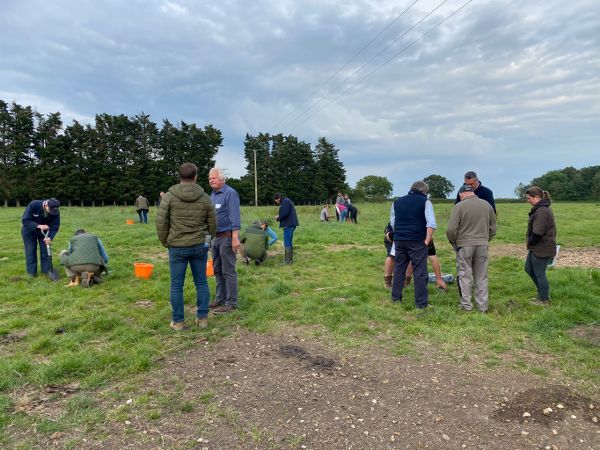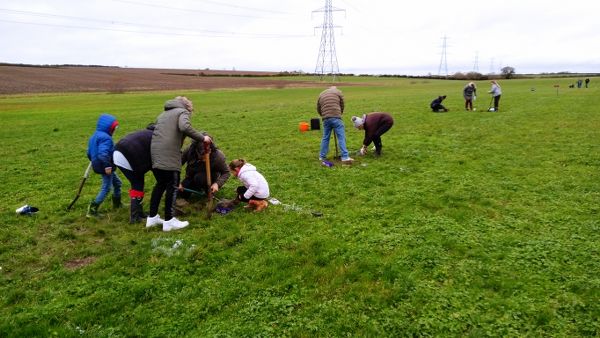Introduction
A Cambridgeshire-based project is testing natural flood mitigation strategies to benefit the local area which is historically prone to flooding.
This project catchment spans over 85 square kilometres, covering two significant watercourses – Alconbury Brook and Milebrook.
Involving a collaboration with local farmers and volunteers, it focuses on natural flood management and soil health, involving enhancing soil infiltration and water retention using deeper-rooted plants.
Flood history and challenges
Flooding has long been a concern for the residents of Alconbury and Alconbury Weston. Over the past 25 years, increasing flood frequency has underlined the need for innovative solutions.
Alconbury Brook reacts quickly to rainfall, leading to rapid flooding. Both Alconbury and Alconbury Weston have a notable history of flooding, with significant events recorded in 1947, 1968, 1987, 1998, 2000, 2016, and most recently, in the winter of 2020/21. The floods of 1998 and 2020/21 were particularly severe, affecting over 100 and 75 properties respectively.
Since 2021, the Alconbury Brook Flood Group has worked on natural flood management strategies to reduce the chance of future flooding.
Natural flood management efforts
Under the guidance of Charles Dalleywater, working with the Alconbury Flood Group, the initiative explores how including deeper-rooted crop species in Countryside Stewardship (CS) mixtures can mitigate local flooding.
“The agricultural catchment has a lot of heavy clay land, with many drainage solutions including ditches and field drains, meaning storm run-off is rapid and flooding occurs quickly,” explains Charles.
“Through a number of experiments, we are looking at the impact of deep-rooted plants over the next five years,” says Charles. “We have a lot of farmers with land dedicated to CS, with herbal leys, grass strips, and winter wild bird mixtures so the idea, if successful, has great potential.
“Farmers require practical and profitable solutions that provide benefits to them while also enhancing water infiltration and retention. We started looking into deeper rooted plants that they could integrate into established CS schemes, with the support of Cotswold Seeds,” he says.
Research
The project is testing deeper rooted varieties against the control of commercial varieties making up CS mixtures – typically with more shallow roots.
“We are testing new mixtures that Cotswold Seeds has helped us to develop, with deeper rooted varieties and we don’t yet know what the outcome will be.
“The primary interest is in soil health,” says Charles.
The Deeper Root project will measure:
Innovative treatments
Several treatments are being tested to support root and microbiome health:
- Cultured rhizobium: Cultured from local fields to help plant nitrogen uptake.
- Mycorrhizal fungi: Enhances nutrient uptake and root health.
- Biological treatments from Unium Bioscience:
- aCalsa: Foliar biostimulant that promotes phosphorus use efficiency and delivers calcium through the leaf into the plant.
- T6P: A signalling compound that accelerates photosynthesis, and balances carbohydrate concentration in the plant, establishing healthier roots and early flower production.
- TARBIS: A foliar treatment that enables plants to fix nitrogen, utilise phosphorus efficiently, and sequester potassium and zinc.
“Research suggests the rhizobium does better in an environment it comes from, and we have successfully cultured rhizobium,” says Charles.
“The biological treatments are scientifically proven to enhance overall plant health in specific ways.
“We’re interested in these treatments helping roots and microbiome and we are looking at soil DNA to give us a picture of how the soil microbiome links with soil health, yield and infiltration,” he says.
Methodolgy
The project employs a structured approach:
- Herbal ley establishment: Introducing cultured rhizobium or mycorrhizal fungi plus combination of both cultured rhizobium and mycorrhizal fungi.
- Sequential biological treatments: Applying aCalsa, T6P and TARBIS.
- Traditional management: Normal farm practices to establish the test and control seed mixes.
“We’re basing the initial experiment on one farm, but we have also found five more farms to partake in the study and help to gather data for us,” says Charles. “We’re also looking at bare earth trials conducted in rented allotments, which have been drilled during this summer, and will be monitored seasonally.”
Collaborators and support
A citizen science group comprising 40 volunteers assists in technical measurements and data collection for the results of the project.
“We hope that farm walks and demonstrations will help to educate farmers on soil health and carbon improvements, encouraging long-term engagement, and Natural England has funded this,” adds Charles.
The project is a collaborative effort involving multiple organisations, including Anglian Water, Natural England, the Cambridgeshire Community Foundation, and Rothamsted Research.
Conclusion
Through innovative natural flood management strategies and active collaboration with local farmers, the Alconbury Brook Flood Alleviation Scheme is paving the way for a more resilient future. By focusing on deeper-rooted plants and advanced soil health treatments, the project aims to reduce flood risks while enhancing the overall agricultural landscape.
The Flood Group produces a monthly bulletin which includes an update on its many projects including the soil science work. This can be accessed at https://www.alconburybrookfloodgroup.uk/newsletters



